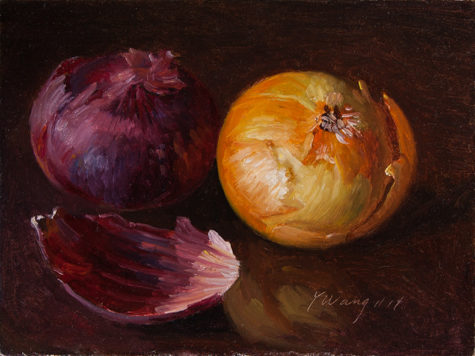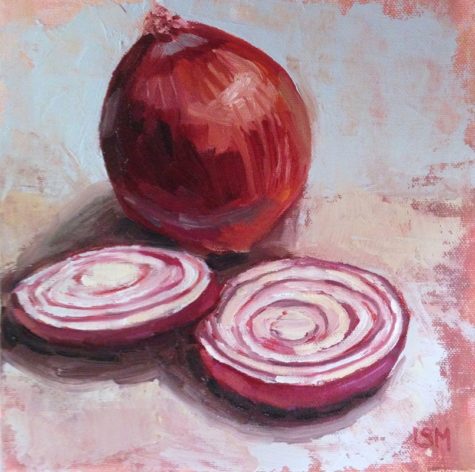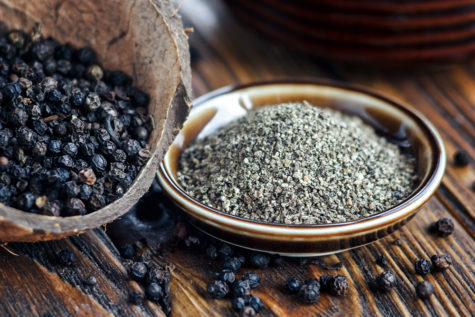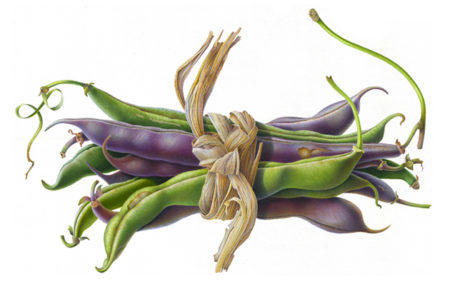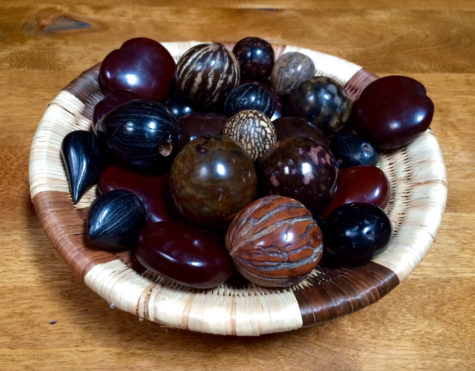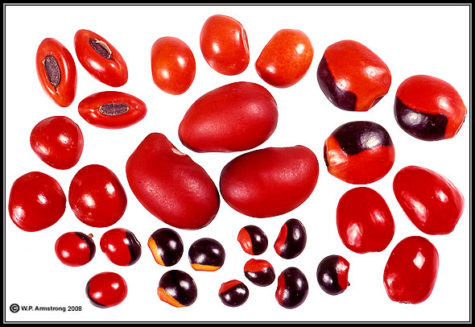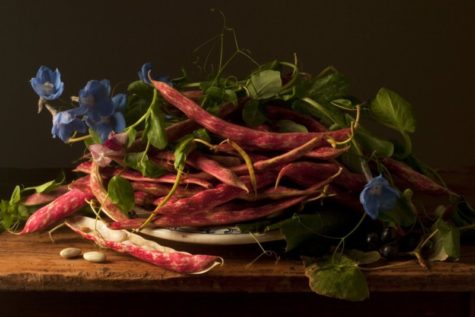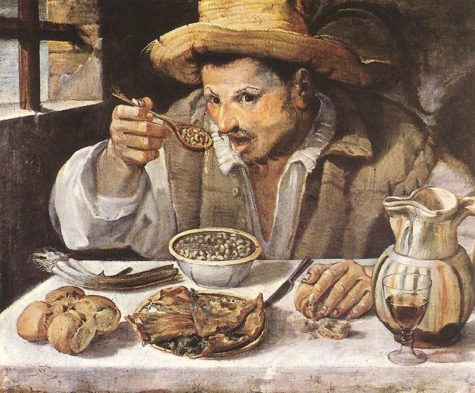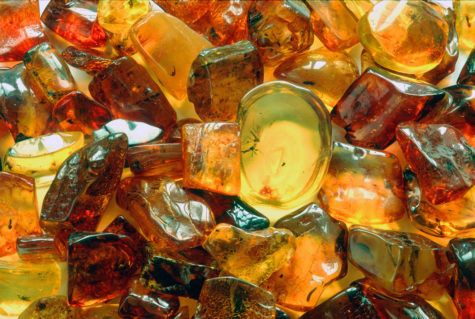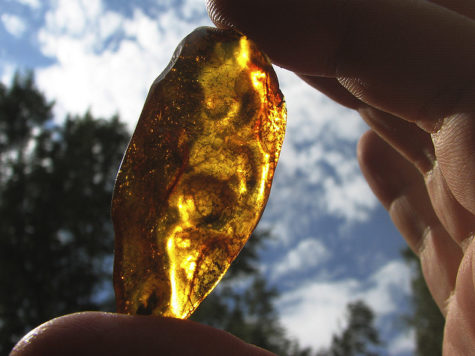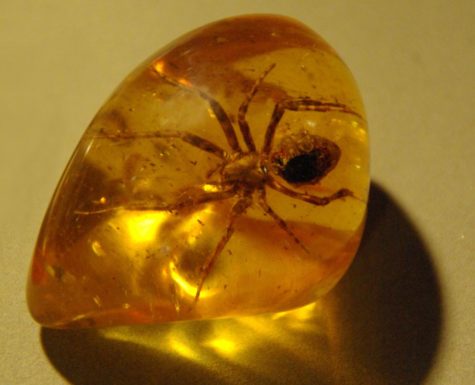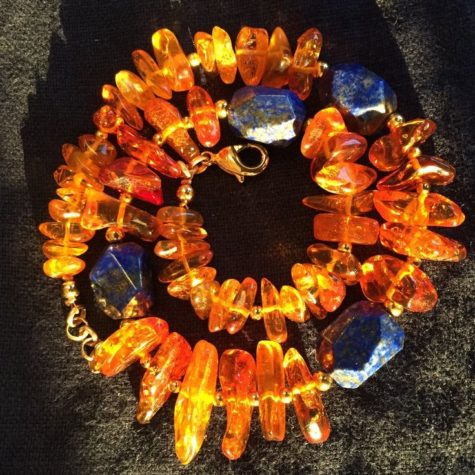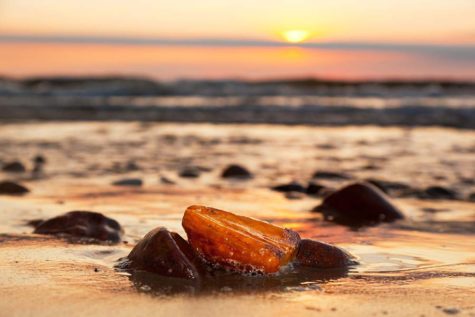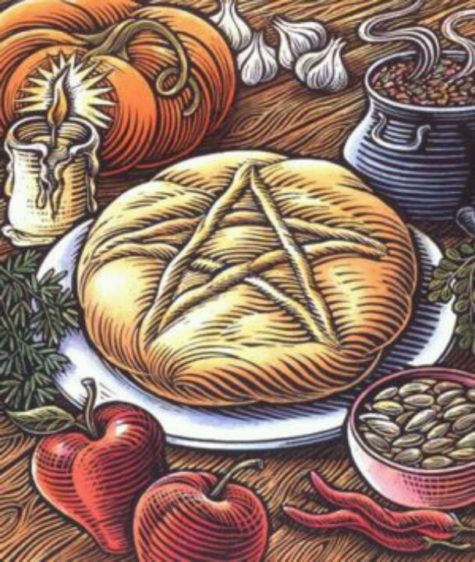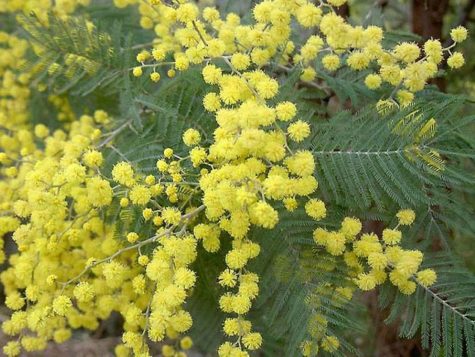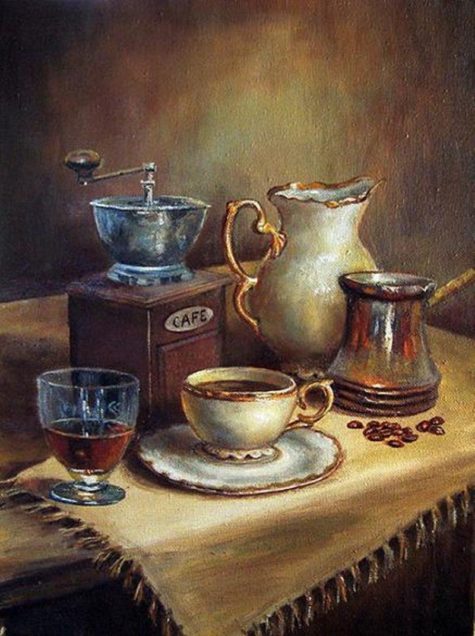Protection
- Planetary Association: Mars
- Gender: Masculine
- Element: Fire
- Deity: Isis
- Basic Powers: Protection, Purification, Exorcism, Healing.
The ancient Egyptians worshiped onions as gods and always planted them in their gardens. Whether your gods are in your garden or the veggie bin of your kitchen, they have many magical uses. Use this many-layered food to peel away problems in life and to dispel anger. The onion is also a love food and is said to increase male virility.
- Red onions promote lust when added to dishes.
- White onions clear away obstacles when peeled to the core.
- Use purple onions for power and seduction.
- Yellow onions dispel anger between friends.
Carve the names of quarreling parties into a yellow onion and keep until it forms roots. At this time, the two friends or family members will begin to recall the positive roots of their relationship and let go of their anger toward each other. Do not get rid of the onion until apologies have been made and accepted. You may then offer the onion to the earth in thanks.
Cut an onion in half and put it under your sink to absorb any negativity in your home or nastiness sent your way and replace every week or two — you’ll be surprised how much it absorbs and how quickly it shrivels. Prick a whole fresh onion with black headed pins and place on a window sill to protect from the evil eye and magical attack. Or, simply braid together onions from your garden and hang them in your kitchen or over your pantry door to protect your home.
Folk healers use onions just like garlic cloves – cut them in half and rub on the afflicted area and then discard. The onion becomes as a scapegoat for the illness. Also, like garlic, onion skins are never thrown out, but burned to attract and keep money. The skins can also be burned for protection and banishing and, when finely ground, can be added to incense blends.
In Hungary, onion skins are burned during childbirth to protect the mother and baby who are believed to be most susceptible to the evil eye and evil spirits at this time. In European folk magic, knives and swords are consecrated by running the blades over the juices of a freshly halved onion – why not use an onion to bless and cleanse your ritual knives before and after use?
Onions are used in the practice of hoodoo/rootwork/conjure and other forms of folk magic in a variety of ways.
- Red Onions
Red onions are powerful, but some folks say that you have to steal one from a grocery store to get the best use of it.
When cutting red onions, take the skin and turn on the stove top. Burn the onion skins in the flames. Folks burn red onion peelings because they are lucky for the home; because they draw in business to a bar, restaurant, or boarding house; because they keep the law away; and because they help in love affairs.
For the last-named purpose, you can call your lover’s name and say, “Hold him tight to me; make him come under my command,” three times as the red onion peels burn.
Red onion skins can also be used without burning them. They can be added to incense, oils, powders, and even mojo bags.
For peace in the home, bore a hole in a red onion, fill it with sugar, tie a shoe lace around it, and hide it above the door where folks will walk under it.
- Yellow & White Onions
An old folk remedy for curing baldness is to rub a cut onion on the head. Yellow and white onions are also used to repel and banish a person.
More Onion Magick
If you want to see your future marriage partner in your dreams, all you need do is place an onion under your pillow. If you are trying to determine between two marriage prospects, you should write their names on two onions, place them on a windowsill, and see which one sprouts first.
Onions are very protective. A half onion is kept in the kitchen to absorb diseases and ill-luck. It should be replaced every few days. The onion’s pungent odor is believed to ward off evil spirits. It also provides general protection.
Rub a cut onion on the door frame and on the ground or floor in a line while stating your desire that whatever it is you are trying to repel cannot enter.
If there is someone in your house and you want them gone for good, take an onion, a name-paper for the person and/or a personal effect from the person. Use a knife to make a slit in the onion. Stuff the name-paper and/or personal effect into the onion. Roll the onion out the house and into the street. If the person is known to sit in a specific chair in the house the you can put it there and then slap it to the floor and kick it out the door and into the street. Cussing the person while you do it will make the work stronger.
Another method of banishing someone is to take a cut onion and rub it on the bottom of their shoes, from the heel going to the toes, while telling them to get the hell out of your house.
If your husband is too demanding for sex, take a cut onion and make one pass down your coochie. He will leave you alone that night.
Onions can be used to break up couples. A hollow is made in a large onion and name-papers or personal effects from the couple are placed into the onion, along with items such as black cat hair, black dog hair, and/or red pepper. The onion is then rolled under the home (if the home is up off of the ground), hidden under the porch, or buried near the front of the house where the couple will walk over it. As the onion rots the couple will begin to fight and will separate.
Carrying an onion around with you is said to be good for your health, and ensures that you do not catch a cold. During the plague, onions were frequently hung up in rooms to help preserve good health. Even today, some people will place an onion in the room of someone who is sick, believing that it will help drive the illness away.
Onion Weather Forcasting:
Onion’s skin very thin,
Mild winter coming in.
Onion’s skin thick and tough,
Coming winter cold and rough.
Onion Tips and Tricks:
Keeping a piece of raw potato in your mouth wile cutting onions will stop your eyes from weeping. Holding a matchstick between your teeth also works.
Sources
This information was collected from a variety of sources including the following:
- Ruler: Mars
- Type: Spice
- Magickal Form: ground, whole
Heat producing and fiery chili pepper makes a great lust ingredient. Add to coconut and chocolate to turn up the flames of desire. Place a circle of red peppercorns around a photograph of your lover to keep others away from him or her.
Pepper is also used for war and separation spells. Sprinkle white pepper in the corners of a room to overcome anger and dissension. Black pepper and peppercorns can hurt others or give protection. Black pepper mixed with salt and sulfur gets rid of someone you don’t want around.
Cayenne pepper makes a good boundary, and can be used to seal a sacred circle protecting those inside the circle from negative or harmful energies.
- See also: Peppercorns and Binding Agreements
One of the oldest and simplest spells in hoodoo is to throw ground black pepper and salt after departing witches or unpleasant people, to prevent them from returning. Sweeping the mixture out after them with a broom makes the trick stronger.
More Pepper Lore
It is bad luck to spill pepper because this will start a fight. The way to remedy this is by putting sugar on the spilled pepper, and leaving it there until it’s cleaned up.
It’s also bad luck to hand pepper to someone. it means you will have an argument with them. Alternatively, if you wish to create problems between a couple, you might be able to organize a situation whereby they hand each other some pepper, in which case, the argument is something you might want.
To prevent something nasty from happening, knock on wood while reciting “peppar, peppar, ta i trä” so they’re not jinxed. It means, “Pepper, pepper, touch wood.”
Sources:
- The Encyclopedia of Magickal Ingredients
- Hoodoo Herb and Root Magic
Many legumes have seeds, called peas or beans, that are lucky. There are also pasture and tree legumes whose leaves and seeds are carried for luck. There is quite a lot of magick and lore surrounding these little packages of energy.
- Ruler: Mercury
- Type: Vegetable, seed
- Magickal form: dried, raw, cooked
Use beans to appease the spirits of the dead. Throw some around the outside of the home if a ghost or poltergeist is bothering you. Beans inspire creativity and communication and can be carried raw in a pouch or cooked and eaten for inspiration.
Here is a list of the different types of beans and their specific properties:
- Black turtle beans help to jump hurdles and make important decisions.
- Butter beans reduce stress.
- Canary beans bring happiness and success in the arts.
- Cow or black-eyed peas bring luck and increase psychic vision.
- Cranberry (October) beans attract new opportunities.
- Fava beans bring power, and make wishes come true.
- Garbanzos (chickpeas) help beat the competition.
- Great northern beans bring discovery and insight; they also help to protect plans and keep them secret.
- Green baby lima beans bring new income.
- Green split peas are for money or health.
- Green pigeon beans represent resourcefulness and money.
- Large lima beans allow expansion and financial growth.
- Lentils bring peace and financial security.
- Navy beans increase strength and determination.
- Oval white beans protect assets.
- Pink beans bring confidence and romance.
- Pinto beans open channels and create action and movement.
- Red kidney beans represent wisdom, love, and healing.
- Roman beans bring power and precision.
- Small red beans provide energy and lust.
- Speckled lima beans create networking opportunities.
- Tonka beans help in romance, often found in love-drawing mojo hands.
- Whole green beans attract money.
- Yellow split peas bring luck and fame.
Two legumes are widely utilized in rituals to cause wishes to come true. The Fava bean is for general good luck wishes, and the Tonka bean is for love-drawing wishes.
Sea Beans
Exotic to the eye, drift seeds, or “sea–beans” are actually seeds from common trees and vines that grow in the tropics. The beans fall from the parent plant, into streams and rivers, to drift with the ocean’s currents until being washed onto a shore thousands of miles from where they once grew. Floating in the sea by the thousands, only the hardiest endure long voyages on ocean currents which may finally bring them to rest on foreign shores. Sea–beans are known as symbols of good luck and longevity.
Sea beans can include the following:
- Sea Hearts
Heart shaped beans such as Entada gigas found on northern Atlantic shores, and Entada phaseoloides and rheedii from the southern Pacific. Sea Hearts are produced in huge, hanging bean pods, up to six feet long. Sometimes they are found with imprints and lacerations, caused by the teeth of fish and mammals during their voyage. They are impervious to salt water, even after floating in the ocean for several years.
These beans have been fashioned into all sorts of trinkets and useful objects. Sailors carried sea hearts as good luck charms to protect them from sickness and to ward off the evil eye. Seeds were sometimes cut in half, the contents removed and the woody seed coats hinged together. Hollowed out seeds were commonly used in Norway and Northern Europe for snuff boxes, match boxes and lockets.
It is said that a sea heart (also known as fava de Colom) inspired Christopher Columbus to set out in search of lands to the west.
- Sea Purses
Purse shaped beans such as Dioclea sp. found on Atlantic beaches, and the elusive Australian Dioclea hexandra. Coveted by collectors, Sea Purses and Saddle Beans (Dioclea sp.) are one of the rarest and most colorful of all sea beans found on any beach. Distinct color variations range from butterscotch to solid black.
It was originally grown in Asia, but has drifted to islands in the Caribbean and Central and South America, reproducing there. They are found growing on the Hawaiian Islands where they may have also drifted or, like so many other species, introduced by people.
- Hamburger Beans
Such as Mucuna sloaneii, urens, and elliptica along with a few south Pacific natives, Mucuna gigantea and membranacea, so called because they look a lot like this popular sandwich.
Seeds from the Mucuna vine are called Hamburger Beans or True Sea-Beans in the United States. In Mexico, they are known as Ojo de Venado or Deer’s Eye. There are hundreds of varieties growing in tropical regions around the globe. They can be brown, red or brindle shades of red and brown.
These beans are members of the pea and bean family that contain toxic, hallucinogenic or medicinal alkaloids and therefore figure in good luck charms.
In the case of the Mucuna bean, the mature beans are considered both aphrodisiac and very protective in Mexico and Central America against the evil eye. Nowadays they are carried for good luck.
- Vine Seeds
Every collector’s favorite, the Mary’s Bean (Merremia discoidesperma) is a rare find among drift material anywhere in the world and highly prized by drift seed collectors. Named after the Virgin Mary, it is also called the crucifixion bean because of a cross etched on one side of the seed, leading to it being used as a talisman and many superstitions and legends are connected with it.
A woman in labor was assured an easy delivery if she clenched a Mary’s bean in her hand, and the seeds were handed down from mother to daughter as treasured keepsakes. In northern Europe the Mary’s bean was a special find to pious beach-combers. The seed had obviously survived the ocean and they felt it would extend its protection to anyone lucky enough to own one.
In addition to its unique appearance, it holds the record for the longest recorded drift: 15,000 miles., along with some Caribbean Little Marbles and Florida native Bay Beans.
Bay beans (Canavalia rosea) are one of the most common and plentiful of all sea-beans growing abundantly in dunes worldwide. The vines and their pods grow low along the sand and are easy to spot on the berm with long flower-studded runners. These vines protect the dunes by stabilizing the sand along with other plants. The coloration of the beans vary from mottled and swirly browns to different shades of beige.
Little Marbles (Oxyrhynchus trinervius), also known as Black Pearls, are plentiful in Nicaragua, Costa Rica and Panama. The parent plant is an aggressive climber in the right conditions. A rare find on North American beaches, as they are not good floaters and few get very far from their parent plant.
- Shrub Seeds
Shrubs that produce these beans are some of the most resilient plants found. They came from parents growing in inhospitable conditions such as drainage ditches, along barbed-wire fencing and embedded in hard-pack soil with drainage that would kill anything else.
Recurved spines growing on their branches protect the precious seeds from animals that probably shouldn’t be eating them. They include Coral Beans (Erythrina sp) and Grey Nickars (Caesalpinia bonduc) and the less aggressive Brown Nickar (Caesalpinia major).
Grey nickars (aka Sea Pearls) found on east coast beaches of Florida may have washed in from the Gulf Stream or are from plants growing locally. The name nicker comes from an old English word meaning marble. Nickernuts are used for playing pieces in board games the world over.
Far less common than Grey Nickarbeans, and a bit larger, the Brown Nickar comes from similar plants, but have the color of light milk chocolate.
- Tree Seeds
All trees produce seeds, but not all are considered beans, much less sea-beans. More often the seed pods have flotation abilities, though short as they are since salt water starts to break them down as soon as they get wet.
Guanacaste (Enterolobium cyclocarpum), one of the most beautiful beans of the New World tropics comes from a huge canopy tree. It is a fast growing species and one of the largest trees found in Central America.
The word Guanacaste, which is also the name of the Costa Rican province of Guanacaste, is of Nahuatl origin and means “ear tree.” The coiled, leathery pods resemble the shape of a human ear. Guanacaste seeds have a distinctive brown “eye” and make some of the most striking seed jewelry.
Makha-Mong (Afzelia xylocarpa). This tree grows in Thailand, Vietnam, Cambodia, Laos and Burma in deciduous forests. In Southeast Asia, the seeds are harvested for medicinal purposes. The seed pulp can be used to make cigarettes, and the bark and seed are used for herbal medicine.
Laurelwood (Calophyllum calaba), also known as santa-maría or false-mamey, this medium-sized tropical evergreen tree is frequently used for reforestation, as a shade tree or a protective hedge. The seeds are perfectly round and coloring runs from light beige to dark brown. At certain times of the year, they can be plentiful on beaches, looking like small ping-pong balls. Polishing brings out their natural coloring.
Royal Poinciana (Delonix regia). In the Caribbean, the pods from these trees are used for fuel and called “woman’s tongue” for the rattling noise they make when the wind blows them. The empty pods are classified as sea-beans but only have a maximum flotation of about a month. The seeds are gathered from pods and fashioned into jewelry around the world.
Large brown beans
Some large brown beans are tropical species that accidentally get distributed worldwide because their pods float. Swept downstream, they make their way to the ocean before the pods fall apart, and when these “Sea Beans” wash up in Northern climes, they are carried as lucky pocket pieces.
Other large brown beans are cultivated as fodder. Their seeds are often mildly toxic, containing DMT compounds or L-dopa, but some find use in local medicine as vermifuges. Most are carried as amulets.
One exception to the “large brown beans are toxic” rule is the greenish-brown Fava bean, which is cultivated for use as a food despite the fact that some people are highly allergic to it. Fava beans are also known as Mojo Beans, or African Wishing Beans and are widely believed to have the power to make wishes come true.
Some large brown beans are drilled through and hung on a cord, often for protection.
Large brown beans are often treated in the same way as other large brown botanical curios like Buckeye, nutmeg, and High John the Conqueror – that is, they are oiled and carried in the pocket as a lucky piece or combined with other curios in a Mojo bag. Sea beans are handled in this way, and in addition to general good luck and gambling luck, being seaborne seeds, they are also said to protect from death by drowning.
Large poisonous brown beans carried as lucky pieces include the following:
- Entada Gigas: Sea heart, Sea bean
- Entada phaseoloides: Matchbox bean
- Mucuna pruriens, Mucuna spp: Cowhage, Cow-itch, Horse-eye nut, Nipay, Ojo de Llama, Ojo de Vaca, Ojo de Venado, Pica-Pica
Small Wild Red Beans and Peas
Many sub-tropical or tropical red beans or red peas are toxic and psychedelic, containing DMT or LSD-like substances. Some are fatal if eaten; others produce a visionary trance or altered state of consciousness. Although local shamans may prepare these dangerous seeds for ingestion, their most common magickal use is in amulets.
One exception to the “red beans are toxic” rule is the kidney bean or red bean well known as food. Like its white, brown, black, and spotted relatives in the Phaseolus genus, it plays an important role in edible bean ceremonies.
Small poisonous red beans crafted into amulets include the following:
- Abrus precatorius: Abrus a Chapelet, Colorine, Crab’s Eye, Jequerite, Jequirity Bean, Lady Bug Bean, Ojo de Cangrejo, Peronilla, Precatory Pea, Rosary Bean
- Adenanthera pavonina: Circassian seed, Jumbie, Jumble Bean
- Erythina spp: Coral Tree, Frijol de Arbol, Gallito
- Ormosia coccinea: Barakaro, Huayruru, Kokriki, Panacoco, Peonia, Wo-ka
- Ormosia macrocalyx: Alcornoque, Chocho Grande, Huayruru, Tento
- Ormosia nobilis: Huayuru Hembra, Mulungu, Tento
Bean Lore
Beans, like many other plants with strong-smelling flowers, are traditionally associated with death and ghosts, and have been so from early pagan times down to our own day.
In ancient Rome, edible beans were distributed and eaten at funerals. Until about the beginning of the 19th century, a similar custom was observed at some, though not all, north-country English burials. When it finally lapsed, a memory of it was preserved in the children’s couplet:
God save your soul,
Beans and all.
During the Roman festival of the dead, held in May, black beans were used in ceremonies intended to placate and ward off ghosts, and in early Greek ritual, the scapegoat who annually died for the people was chosen by means of a black bean drawn in a lottery.
In his Remaines of Gentilisme and Judaisme (1686) Aubrey mentions a charm used in his boyhood to avert evil spirits, which consisted in saying very quickly, three times in one breath:
Three blew beans in a blew bladder,
Rattle, bladder, rattle.
A very widespread country belief that persisted at least as late as the end of the last century, and perhaps later, was that the souls of the dead dwelt in the flowers of the broad bean. These flowers were still thought to be ill-omened in many districts. Old colliers in northern and midland England say that accidents in the pit occur more frequently when they are in bloom than at any other time.
Cases of lunacy are also thought to be more likely then, for the scent of the flowers is supposed to induce mental disorder, bad dreams, and terrifying visions. A Leicestershire tradition says that if any one sleeps all night in a beanfield, he will suffer from appalling nightmares, and will probably go mad afterwards.
Another very common superstition is that if in a row of beans, one should come up white, it is a death omen for someone in the grower’s family.
A well-known charm for curing warts is to rub them with the white inner lining of a bean pod, and then throw the pod away, or bury it in a secure place. As it rots, so will the wart disappear. This charm has been tried with success in Oxfordshire within the last ten years.
In Ireland, poultices made from the flowers were sometimes used to reduce hard swellings. A former use for the plant, half medical in origin and half magickal, was to make women beautiful. The pods steeped in wine and vinegar, or the distilled water of the flowers, improved the complexion, and so, according to Bulleyne’s Booke of Simples (1562) did a lotion made from bean-meal mixed with cold milk.
In Leap year, broad beans are said to grow the wrong way up. Various dates are given in different districts (in England) as the only fortunate days for setting beans (and peas) but these seem to spring less from superstition than from agricultural custom and the knowledge of local weather conditions. In the northern counties gardeners should:
Sow peas and beans on David and Chad,
Whether the weather be good or bad,
David and Chad refers to March 1st and 2nd, the festival days of St David and St Chad. Farther south, beans are set “when elm leaves are as big as a farthing,” or on certain dates in early May, often connected with local fairs. A limit to the variety of these days seems to be set by a well known rhyme which says:
Be it weal or be it woe,
Beans should blow before May go.
Edible Bean Ceremonies and Celebrations
Edible beans have had religious and magickal associations for millennia. The ancient Egyptians held the red kidney bean sacred, and thus taboo as food. The high priest of the Jews was forbidden to eat beans on the Day of Atonement. Beans were thrown to the spirits of the dead during the ancient Roman feast of Lemuria in May.
Bean soup is eaten to commemorate the dead on All Souls Day in Austria and is also a feature of Jewish mourning feasts. Bean cakes are eaten in Taiwan at the August full moon ceremony. New Year’s luckiness is associated with red kidney beans in many parts of the world including Europe, where the beans are eaten, and in Japan, where priests clap their hands and throw uncooked beans upon temple goers.
Sources:
- Encyclopedia of Magickal Ingredients
- Encyclopedia of Superstitions
- Hoodoo Herb and Root Magic
- Beach Beans – a source for sea beans
- Ruler: Sun
- Type: Mineral
- Magickal form: Resin, gemstone, essential oil
While often considered a gemstone, the glowing, warm amber is not actually a stone, but a fossilized resin from ancient evergreen trees. The oldest amber discovered on Earth is about 320 million years old. Imagine the incredibly powerful energy this amber contains!
Before man knew where amber came from, there were many ingenious theories as to its origins. Lynx urine, said some; others believed that it was chunks of the rays of the Sun, set hard in the sea and then washed upon the shore.
Like jet, amber burns easily, and it was for this reason that in Germany it was called Bernstein, meaning “burn stone.” The scent given off by burning amber was believed to drive away evil spirits.
Magickal Uses
The most obvious quality of amber is its old, old, (very old!) energy. With it comes the accumulated wisdom of the earth and its natural kingdom. You can often see little insects trapped in the amber while it started as a tree resin; this gives the amber stone quite powerful magical properties.
Amber is used as prayer beads in Christian and Muslim practice, is also known as the ‘Witch’s Stone’ and is used in Wiccan practice. It is worn for general good luck, financial stability and toward off danger from witchcraft.
Amber beads are perceived as bolstering health, however, not just any amber beads will do. Amber beads carved into the shapes of genitals, whether very literally or just vaguely reminiscent, allegedly provide protection, especially regarding health. Wear or carry as needed.
Due to its strong connection to nature and the earth, Amber is a great stone for grounding our higher energies. Amber can add stability to your life.
- Amber is known to calm energies, attract love, inspire change and improve wisdom.
- Wear or carry amber for protection and success.
- A piece of amber that contains a beetle or fly trapped within its center is said to bring fame.
- It has been used as a symbol for the renewal of marriage vows and to assure promises.
- Amber has been said to bring good luck to warriors.
Amber is an Aura cleanser. It glitters like dew drops in the bright sun light. It assists in bringing our higher vibrations in order, dispersing negative energy and clears the surrounding environment. Amber is the stone, which brings about altruism and great wisdom.
Amber allows the body to heal itself by absorbing and transmuting negative energy into positive energy. It emits a sunny and bright soothing energy which helps to calm nerves and to enliven the disposition.
Amber has uplifting energies, and is especially helpful when you are felling weighed down with responsibilities, it is good for people with suicidal tendencies and those who easily get depressed. Helps you find humour and joy. Creates a balance between daily life and spiritual expansion.
Utilise Amber when you are feeling powerless or out of control, to remind you of your inner strength and past achievements. It brings balance and patience and encourages decision-making, promotes a positive mental state and creative self-expression. Its flexibility dissolves opposition.
Amber stimulates memory thus making it a good stone for studying. Amber is used for past life work, divination and scrying. It aligns mental and emotional bodies via its deep orange and yellow colour.
Amber is highly recommended for those who often have to meet challenging situations and at times frustrating atmosphere. It is good for those involved in political life and those wishing to have governmental patronage. Good for those interested in nobler types of deeds and social and humanitarian causes.
Amber is a powerful healer and cleanser that draws die-ease from the body and promotes tissue revitalization. It imbues the body with vitality and has the power to draw dis- ease out of the body. By absorbing pain and negative energy, Amber allows the body to balance and heal itself. Amber alleviates stress.
Add the resin to prosperity formulas and wear the oil for protection or to empower your magickal path. Men may wear amber essential oil to attract lovers.
It cleanses the environment in which it rests and is an excellent mineral for use in purifying birthing and re-birthing rooms. It also acts to purify ones body, mind, and spirit when worn, carried, or used as an elixir.
Cleansing:
Amber should be cleansed after being used for healing to dispense the negative energy it has absorbed. It tends to become cloudy when used for treating negative energy. Cleanse this stone by running it under warm water or charge it over night in a bowl of tumbled hematite. Be careful as this stone will become brittle in sunlight if left out for a long period. It should be kept away from heat or sun.
Properties and Colors:
The color depends on source and impurities. A deep tawny yellow is the predominant color, but it also comes in blue, violet, brown or even black. Amber that is green is colored artificially. Yellow and brown are the most common colors, other colors are extremely rare.
Because amber was once a liquid, sometimes small insects or bits of organic matter can be seen embedded within it.
The fossilized resin ranges from transparent to opaque. Transparency depends on gas bubbles. It is a lighter gem stone and softer than pearl. It becomes electrically charged when rubbed; indeed, the word “electric” comes from the Latin word electrum, which means amber.
Uses in History:
Amber has a rich history and has been used since prehistoric times for jewelry, religious objects, healing, also as amulets and mascots. The Baltic amber, the “gold of the North” is among the earliest-used gem materials.
Amber has a long history of being used in sacred incense and worn as a healing stone by Asian and American Indian cultures for centuries. This organic gem can date between 1 and 360 million years. Archaeologists have found amber artifacts dating back to such cultures as Assyrian, Egyptian, Phoenician and the Greek and Roman periods. It is known by the Persians as the “attractor of straw”, by the Greeks as “sun gold” and derived from the Arab name “al-anbar”.
The Greeks believed that amber was the petrification of sunrays; some even felt that it was petrified tears. They prized amber for the magical properties that electricity exhibited when rubbed. The term electricity is derived from the Greek word, elektron, which is also the Greek word for amber.
In the Far East, amber is the symbol of courage; Amber was considered the “soul of the tiger” in Asian cultures and regarded as the stone of courage. Pieces of amber were carried for protection during long travels, as well as used to treat jaundice.
Egyptians placed a piece of amber in the casket of a loved one to ensure the body would forever remain whole.
It is a sacred stone to both the Native American and Eastern Indians. It has also been used in the fire ceremonies of ancient tribal leaders. It was burned, beginning in medieval days, as a fumigant and as an incense to clear the environment of negativity.
In ancient times it was used as a penicillin-type remedy, ground and ingested or soaked (as in an elixir) and subsequently drunk.
Uses In Healing:
Amber will help relieve a tension headache, place on or around the head. It is excellent at detoxification and protection from radiation, especially x-rays, sun, computers, airport, planes and other people’s energies.
Make an elixir with this stone for wound healing and to apply to all pain issues. It is an excellent natural antibiotic.
Wear amber around your throat to heal asthma and prevent attacks. Minimize and ward off chills by wearing tightly beaded amber necklaces. Amber is believed to absorb body heat and retain it, thus magickally creating a balancing effect.
When used at the solar plexus, Amber will enhance intellectual clarity about your future path. It can stimulate the navel chakra and help in grounding energies into the body.
Amber as jewelry, it can be grounding and stabilizing. Wear for prolonged periods, especially on the wrist or throat, or place as appropriate. If treating babies or children, it is beneficial for the mother to wear the stone first.
It resonates with the throat, treating goiters and other throat problems. It treats the stomach, spleen, kidneys, bladder, liver, and gallbladder, alleviates joint problems and strengthens the mucus membranes. Amber is known to stimulate metabolism and treat skin disorders. It is also a good stone for treating asthma and allergic reactions.
Feng Shui:
Amber is used in the Center/Health position to encourage good health and create balance and calm. Use it in the Northeast area for self cultivation and wisdom, in the Southwest area for partners, love and relationships (use in pairs) and for dispersing negative energy in any room. Use it in any room to also attract change into your space.
Associated Deities:
Amber is thought to be the tears of the Goddess Freya that fell into the sea. It is used to honor her. Additionally amber is used in devotions to Elektra, Greek Goddess of the Sea, Jurate, the Lithuanian Goddess of the Sea, Nehalennia, the Gaulish Goddess of Sea Travelers, Oshun, the African Goddess of Love, Intimacy, Beauty, and Diplomacy, and Amberella, the Lithuanian Goddess of the Oceans.
Honor the Goddess Electra with amber. We get our beautiful amber from the sea. Interestingly, when you rub amber with a soft cloth you will produce static electricity – honoring Electra as you do. Wear an amber necklace or pendant when you are feeling a bit “stormy.” Use it when you need to make things better but you have to use a bit of force to get the job done. Electra will help you.
The preparation of food, with a particular intention in mind, is old magick. Look at food as sacred, let the act of preparing, cooking and eating food be a sacred act. Your kitchen can be a place of powerful magick, work slowly and deliberately to hone your craft.
When preparing foods for specific magickal purposes, cook with purpose and care. Keep your goal in mind, love, money, protection, health, fertility, sex, strength, psychic awareness. Always stir clockwise, clockwise motion is thought to be in harmony with the apparent movement of the sun in the sky, and has been linked with life, health and success. Cut foods into shapes symbolic of your magical intention, such as a Pentagram for protection etc.
The following foods can be used, prepared, and eaten with protection as the intention, and used in conjunction with your protection spells.
- Artichoke
- Basil: (also love and money)
- Bay leaf: (also psychic awareness and healing)
- Black Pepper: (also purification)
- Blueberry ice cream
- Broccoli
- Brussels Sprouts
- Chili peppers
- Chili powder
- Chives: (also health)
- Cloves: (also love and money)
- Cranberries
- Fennel: (also strength and health)
- Garlic: (also health)
- Horseradish: (also purification)
- Leek: (also strength)
- Mango: (also sex and love)
- Marigold: (also happiness)
- Mustard: (also courage)
- Onion: (also health)
- Parsley: (also sex and money)
- Pineapple: (also healing, money, love)
- Pineapple pie: (also love, healing, and money)
- Potato: (also compassion)
- Quince: (also love)
- Radish
- Rhubarb: (also love)
- Salt: (also grounding and purification)
- Soy: (also awareness and spirituality)
- Sunflower: (also success)
- Tangerine
- Tomato: (also health, money, and love)
- Vinegar: (also purification)
- Walnut: (also conscious mind)
- Watercress: (also fertility)
Source: Witches Lore
According to Celtic tree mythology, the Silver Fir is the tree of the day of the Winter Solstice. The Winter Solstice. This usually takes place on December 20th or 21st, although it does sometimes occur on the 22nd or 23rd (check your calendar as it changes from year to year).
- Latin name: Abies alba.
- Celtic name: Ailim (pronounced: Ahl’ em).
- Folk or Common names: Common Silver Fir, Balm of Gilead Fir, Balsam Fir, American Silver Fir.
- Parts Used: Needles, wood, sap
Magical History and Associations:
The Silver Fir is associated with the moon and with the planet of Jupiter. Its colors are piebald and light or pale blue. Its birds are the eagle and the Lapwing, and its animal association is the red cow. Its stones are Tourmaline and Amber – and it is a feminine herb. This tree belongs to the triple aspect Goddess in Celtic lore, offering learning, choice and progress. The tree is sacred to many Goddesses: Artemis (the Greek Goddess of Childbirth), Diana and Druantia among them. It is also sacred to the Gods Osiris and Attis, both who were imprisoned in Fir/Pine trees.
Magickal usage:
Burn to cleanse a room of negative vibes. This is a wonderful incense for healing and strengthening the physical, emotional, and spiritual body. The scent opens the heart and increases endurance.
The Silver Fir is used for magick involving power, insight, progression, protection, change, feminine rebirth, and birth. The Silver Fir and the Yew are sisters standing next to each other in the circle of the year and their foliage is almost identical. However the Yew is known as the tree of death and the Silver Fir is the tree of birth or rebirth. The Silver Fir was a sacred tree to the Druids who felt that it stood for hope. The Silver Fir wood is used for shape-shifting and magic involving change, since it offers a clear perception of the present and the future.
The wood chips are sometimes used as incense and the wood can be used in the construction of magickal musical instruments. Burning the needles of the Silver Fir or sweeping around the bed with a branch that has been blessed will protect a new born baby and its mother. In the Orkney area of Scotland, the new mother and baby are ‘sained’ by whirling a fir-candle three times around her bed.
For a ‘Weather Witch’ the cones of the Silver Fir warn of wet weather and foretells when a dry season approaches. Charms made of Fir can be given as good luck tokens to departing friends. In its appearance (and in its current, and undoubtedly ancient, use) the Silver Fir is the quintessential Yule tree. Its branches can be used as decorations at Yule time either as wreaths or as garland, where it will provide protection for the household and its occupants.
Recommended Reading:
- Year of Moons, Season of Trees
- Tree Medicine Tree Magic
- A Druid’s Herbal
- Celtic Astrology
- Glamoury: Magic of the Celtic Green World
- The Book of Druidry
Source: Dutchi.org
- Ruler: Venus
- Type: Baked good
- Magickal form: Various fillings
Originating in ancient Greece and Rome, pies are associated with happiness, love, and wholeness. Eat cherry pie to increase self-confidence and find self-love. All fruit pies invoke love when shared with another. Meat pies create fillings of security. Place your thumb in a pie and make a wish, it might come true.
Mince pie magick and lore:
Mince pies (sometimes known as mince tarts) are a popular part of Christmas. Most people think they will gain a month of good luck for every mince pie they eat during the Christmas season, as long as a different person makes each pie. One hundred years ago, the tradition was that each pie had to be eaten at a different person’s house, and they had to be consumed between December 25 and January 6. This gave you twelve days in which to eat enough pies to guarantee a year of good luck.
The mincemeat mixture should only be stirred in a clockwise direction. To stir it anticlockwise is to bring bad luck for the coming year. A wish should be made whilst eating your first mince pie of the festive season.
Pies and Their Magickal Qualities:
- Apple pie: Love, Healing, Peace
- Banana cream pie: Money
- Blackberry pie: Money, Sex
- Chocolate cream pie: Money, Love
- Cherry pie: Confidence, Self esteem, Love
- Lime pie: Love, Purification
- Lemon pie: Purification, Love
- Mince pie: Luck, Money (always make a wish when eating a mince pie)
- Pecan pie: Money
- Pineapple pie: Love, Healing, Money, Protection
- Pumpkin pie: Money, Healing
- Raspberry pie: Happiness, Love, Protection
- Rhubarb pie: Protection, Love
- Square sweet pies: Prosperity
- Strawberry pie: Love
From: Encyclopedia of Magickal Ingredients and other sources
- Ruler: Zeus, Obatala, Ra, Bast, solar deities
- Type: Plant
- Magickal form: oil, bark, branch, flower
- Other names: Cassie Flower, Catechu, Egyptian Thorn, Gum Arabic, Cape Gum
- Basic powers: Protection, Clairvoyance
Acacia is much revered in religious and magickal practice as an emblem of immortality and of initation, in the sense that initiation is symbolic of resurrection. The ancient Egyptians made funeral wreaths of Acacia leaves and the Hebrews planted a sprig of evergreen Acacia to mark the grave of a departed friend.
Carry the wood as a protective amulet.
Acacia wood is the Biblical shittim-wood from which Noah’s Ark and the Tabernacle and Altar wer made. Jewish legend tells us that the Burning Bus of Moses was an Acacia. Christian lore links an Acacia tree with the Cross and its spiny branches with the Crown of Thorns. The sap of some spiny Acacia species yields Gum Arabic, used as a binding agent.
Sitting under an acacia tree or burning the dried flowers brings wisdom and insight. The oil extracted from the plant is considered holy and used for purification and anointing. It is especially powerful when attempting to contact the dead and should be rubbed into white candles and not worn on the body while attempting such work. For personal anointing, mix with other oils (like musk or camellia) to cut and then it is said to bring happiness.
- To contact the dead:
Dip acacia leaves in holy water and sprinkle an altar with the water, or burn Acacia as incense to communicate with or to memorialize the dead.
- To open the mind to visions:
Acacia leaves are burned on charcoal to induce spiritual phenomena and develop personal psychic power; adding Frankincense and Myrrh is used to intensify the effect.
The Poplar or Aspen is the sacred Tree of the Fall Equinox – (Aprox. September 22).
There is a bit of confusion about poplar, aspen, and cottonwood trees. The tree referred to here is the genus “populus” which includes true poplars, as well as related trees such as cottonwood and aspen).
Here’s a quick list:
- Balsam Poplar (Populus balsamifera)
- Eastern Cottonwood (Populus deltoides)
- Bigtooth Aspen (Populus grandidentata)
- Black Poplar (Populus nigra)
- European Aspen (Populus tremula)
- Quaking Aspen (Populus tremuloides)
- Black Cottonwood (Populus trichocarpa)
As far as I could discover, the Aspen and Poplar tree magickal lore overlap, and can be used interchangeably, unless otherwise indicated. The lore does not refer to the Yellow Poplar (Liriodendron tulipifera), or Balm of Gilead (Populus candicans) which have different attributes and magickal qualities
- Celtic name: Eadha (pronounced: “Eh’ uh”).
- Folk or Common names: All Poplar – Popple, Alamo, Aspen; Trembling Poplar – American Aspen, White Poplar, or Quaking Aspen; Balm of Gilead – bombagillia.
Magickal Usage:
- Ruler: Saturn
- Type: Plant
- Magickal form: Buds
Carry poplar buds with you when seeking employment. Crush and add them to traditional money incense when you work on commission and need to attract more funds. The poplar buds may also be added to divination blends and make a great ingredient for psychics wishing to attract more business, as well as improving their powers.
The Poplar’s ability to resist and to shield, its association with speech, language and the Winds indicates an ability to endure and conquer. The Poplar is known as the “Tree that Transcends Fear”. Poplars symbolize the magick of joy, the aging of the year, resurrection and hope – and are connected to the Otherworld. Poplar can be used in magick done for success, passage and transformation, Hope, rebirth, divinations, shielding, endurance, agility in speech and language, protection, and love – and as an aid in astral projection.
Poplar can be used in protection charms of all kinds. Poplar is a good wood to burn in balefires and ritual fires since it offers protection. Shields can be made of Poplar since the wood is thought to offer protection from injury or death. Carrying Poplar helps to overcome the urge to give way under the burden of worldly pressures, and aids in determination. Poplar buds can also be carried to attract money and can be burned as an incense to create financial security.
Siberian reindeer-hunting cultures carved small goddess statues of Poplar (Aspen) wood. Groats and fat were then offered to the figures with this prayer:
“Help us to keep healthy!
Help us to hunt much game!”
Poplar buds are also sometimes added to flying ointments and was also used in astral travel. A medieval recipe for a flying ointment called for Cinquefoil, Poplar leaves, soot and bat’s blood obtained at the wake of the new moon.
The trembling leaves of the Poplar tree can be ‘read’ to divine messages from the God and Goddess, and also from spirits that drift into woods. The Poplar is the sacred World Tree of the Lakota nation. For the sun dance ceremony, a Poplar is carefully cut and lowered, then is re-erected in the center of the dance circle. While being carried the Poplar must never touch the ground. Green branches, a buffalo skull and eagle feathers were used to decorate the Poplar for this ceremony.
Aspen Lore:
A country name for the aspen is the Shivver-tree, a name which in some districts is also given to the poplar. The leaves of both trees tremble at the slightest stirring of air, so that they seem to move without ceasing when all around is still. Because of this, both trees were formerly credited with the power to cure agues and fevers.
A very old magical tradition held that ailments could most efficaciously be treated by something that resembled their effects; and since ague causes the patient to shake and tremble, he was likely to be healed by the shaking tree.
In his Folk-Lore of the Northern Counties, William Henderson relates the story of a Lincolnshire girl who was thus cured of ague. She was advised to pin a lock of her hair to an aspen, saying as she did so:
“Aspen tree, aspen tree,
I prithee to shake and shiver
Instead of me.”
As was usual in such charms, her journey home had then to be made in complete silence, otherwise the magic would not work. She followed the advice given, and many years later, when she was an old woman, she told Henderson’s informant that she had never been troubled with ague again.
Another method was to bore a small hole in the tree trunk, insert the patient’s nail parings, and close the hole securely. As the bark grew once more over the opening, so the disease would disappear.
Two widespread legends are told to account for the aspen’s trembling. One is that it was condemned to shiver thus for evermore because it was the only tree that would not bow down to Our Lord when He passed through the forest. The other is that it shudders perpetually with horror because its wood was used to make the Cross on Calvary.
Poplar Lore:
 The poplar shares with the aspen the country name of Shivver-tree because like those of the latter, its leaves tremble. It also shares, and for the same reason, the aspen’s power to cure agues and fevers. R.M. Heanley records a Lincolnshire charm in which the patient cut off a lock of his hair and wrapped round a black poplar branch, saying as he did so:
The poplar shares with the aspen the country name of Shivver-tree because like those of the latter, its leaves tremble. It also shares, and for the same reason, the aspen’s power to cure agues and fevers. R.M. Heanley records a Lincolnshire charm in which the patient cut off a lock of his hair and wrapped round a black poplar branch, saying as he did so:
When Christ our Lord was on the Cross,
Then didst thou sadly shivver and toss.
My aches and pains thou now must take,
Instead of me I bid thee shake.
He then had to go straight home, speaking to no one on the way, after which he would be free from ague forever. Heanley adds that some people considered it necessary to fast for twelve hours before attempting this charm.
The constant shaking of the poplar is often accounted for by the legend that its wood was used in the construction of the Cross. Medieval Legends of Christ (1934), mentions two explanatory legends. One is that it was under a poplar that Our Lord prayed during His agony in the Garden of Gethsemane, and that the tree has trembled in sympathy ever since. The other is that it was cursed because, alone among the trees, it refused to mourn at the Crucifixion, saying that Christ died for sinners, “but I am innocent, and His suffering is no concern of mine.”
Poplar leaves were supposed to be one of the ingredients of the witches’ flying ointments.
Magical History and Associations:
In Gaelic tongue the tree was called Peble and Pophuil in the celtic way. Poplar is generally a plant of Jupiter, Saturn and the Sun and is associated with the element of water. Its color is rufous (red) and the bird associated with Poplar is the Whistling Swan. The stones associated with Poplar are Amber, Citrine Quartz, Sapphire and Swan Fluorite. The Anglo-Saxon rune poem seems to refer to the Poplar as being associated with the rune “berkano”.
Heracles wore a crown of Poplar leaves in triumph after killing the giant Cacus (the evil one) and retrieving Cerberus from Hades. The upper surface of the Poplar leaves was thus darkened from Hades’ smokey fumes. Poplar trees are sacred to the Mesopotamian goddess Ua-Ildak. The Grass King of Grossvargula, who was seen as having fertilizing powers, went on horseback wearing a pyramid of Poplar branches and a crown. He led a procession of young men about the town and was then stripped of his branches beneath the Silver Lindens of Sommerberg.
Poplar (Aspen) is said to be the tree of the Autumn Equinox and of old age, and is known as the shield makers’ tree. The Black Poplar was a funeral tree sacred to Hecate as death goddess, to Egeria, and to Mother Earth. Plato makes a reference to the use of Black Poplar and Silver Fir as an aid in divination. The Silver Fir standing for hope assured and the Black Poplar for loss of hope. The Grove of Persephone in the Far West contained Black Poplars and old Willows.
In ancient Ireland, the coffin makers measuring rod was made of Aspen, apparently to remind the dead that this was not the end. In Christian lore, the quaking Poplar (Aspen) was used to construct Christ’s cross, and the leaves of the tree quiver when they remember this fact.
Herbal usage:
Poplar can be used as a tonic, chiefly used in treating fevers. The infusion has been found helpful in treating chronic diarrhea. The sap collected from the buds can be used to make a healing ointment and can be used as an external application in bruises, swellings, and some skin diseases. Teas can be made from the Poplar buds and are useful in helping treat arthritis and rheumatism.
Source: Dutchie.org
- Provides peace of mind and grounding.
- Helps to dispel nightmares, negative thoughts, and overcome blockages and unhealthy emotions. It’s great for protection and getting rid of all kinds of nasties.
- Coffee is a stimulant and can be used to give spells, potions and charms an extra kick, or speed things up.
- Coffee grounds can be used in divination and read like tea leaves.
- It is considered excellent for curse breaking.
- It can be used as an offering to deities, entities, and ancestors.
- Some sources suggest it can be used for compulsion, and encouraging others to be more persuasive towards you. This is most effective when the coffee is served to the target.
Bubbles appearing in a cup of coffee are a sign of good luck, especially if they are caught with a spoon and eaten. This is hard to do, as the bubbles disappear quickly. However, anyone who achieves it will receive a surprise windfall.
The movement of any bubbles on the surface of a cup of coffee can be interpreted. It is a sign of money ahead if they move toward the drinker. Unfortunately, it means the opposite if they float away from the drinker.
It is bad luck to stir coffee with a fork.
Muslims believe the archangel Gabriel invented coffee. One day when Mohammed was extremely tired, Gabriel brought him a cup of coffee. This invigorated Mohammed so much that after drinking it he defeated forty horsemen and satisfied forty women.
Borrowed from: The Prosperity Project and The Encyclopedia of Superstitions
